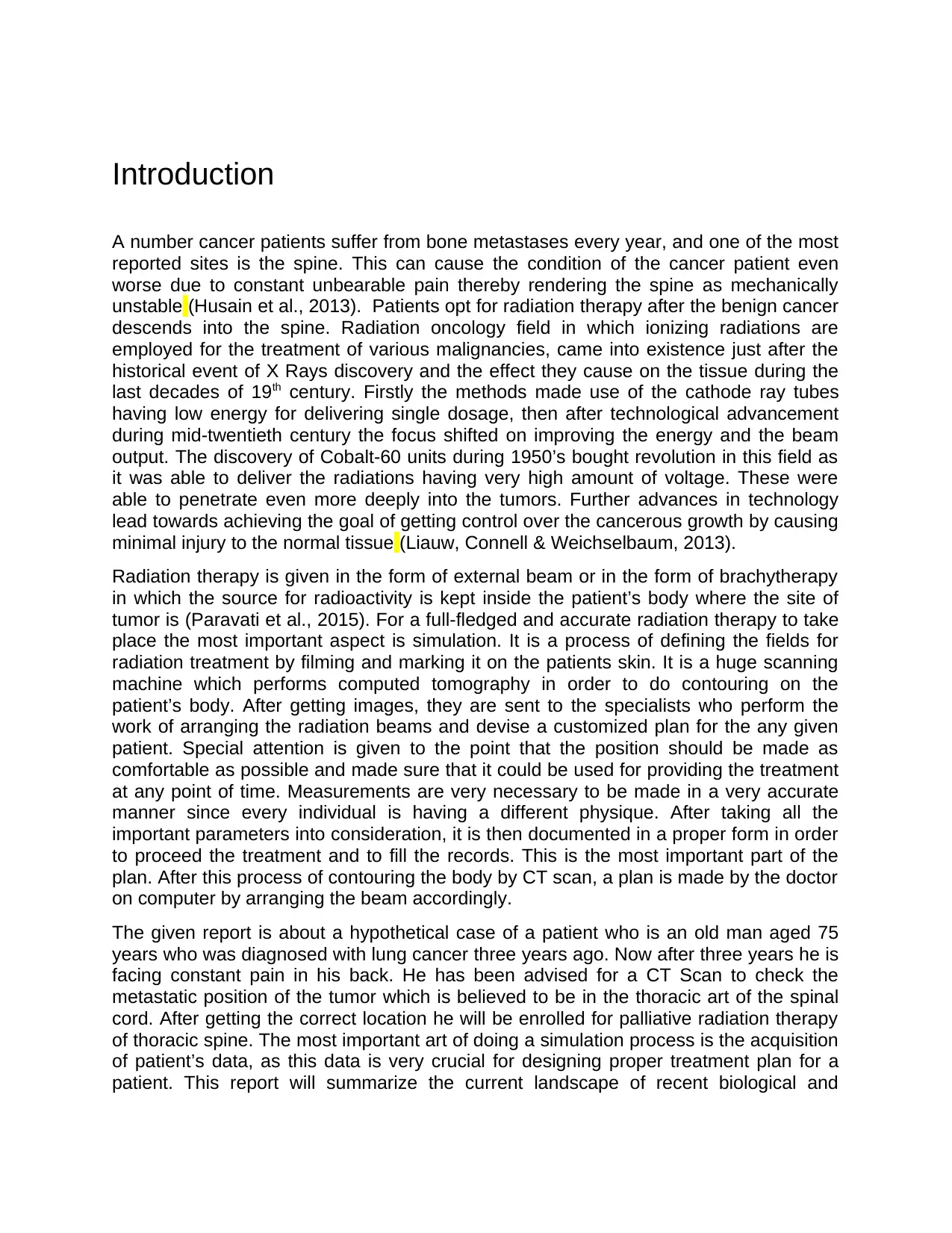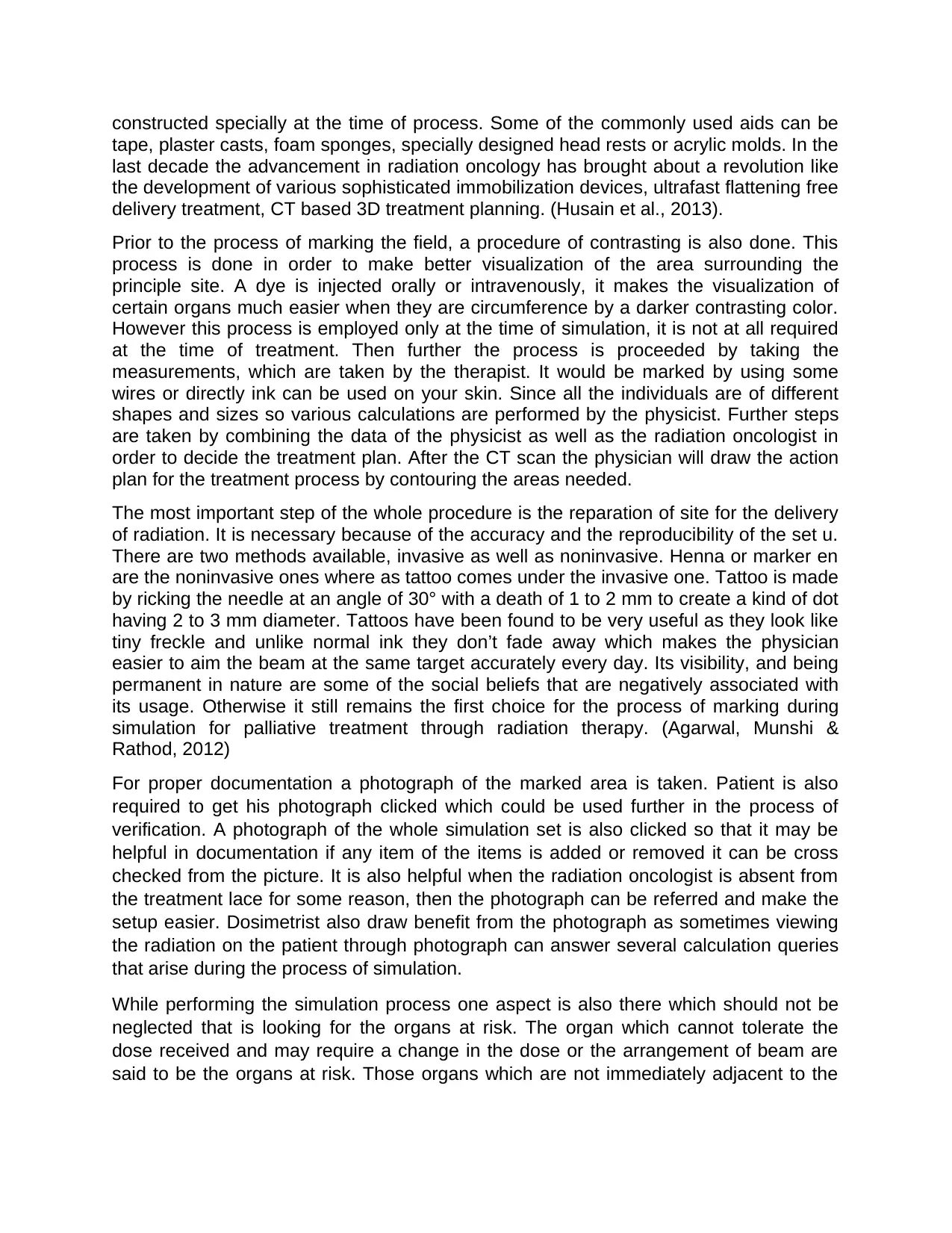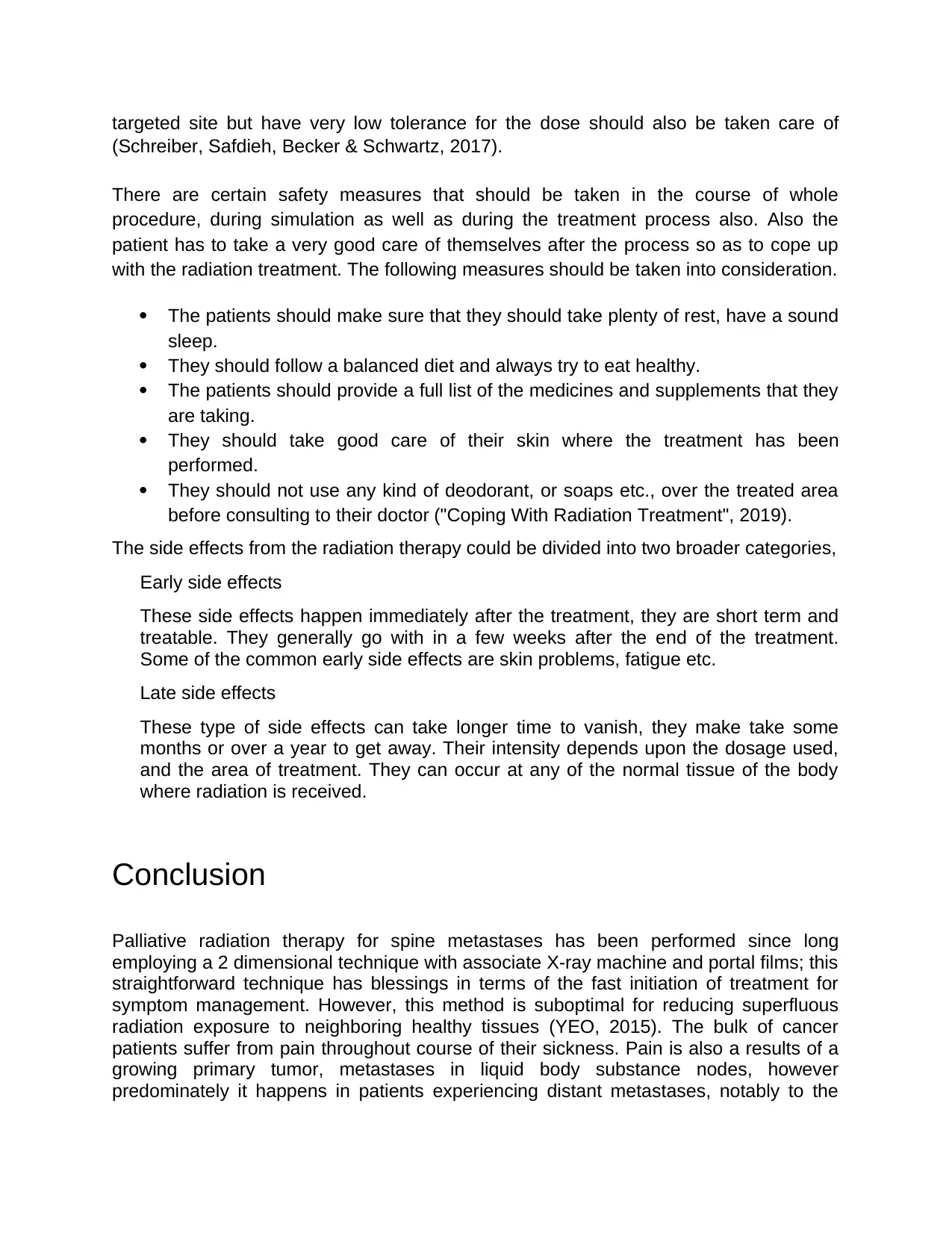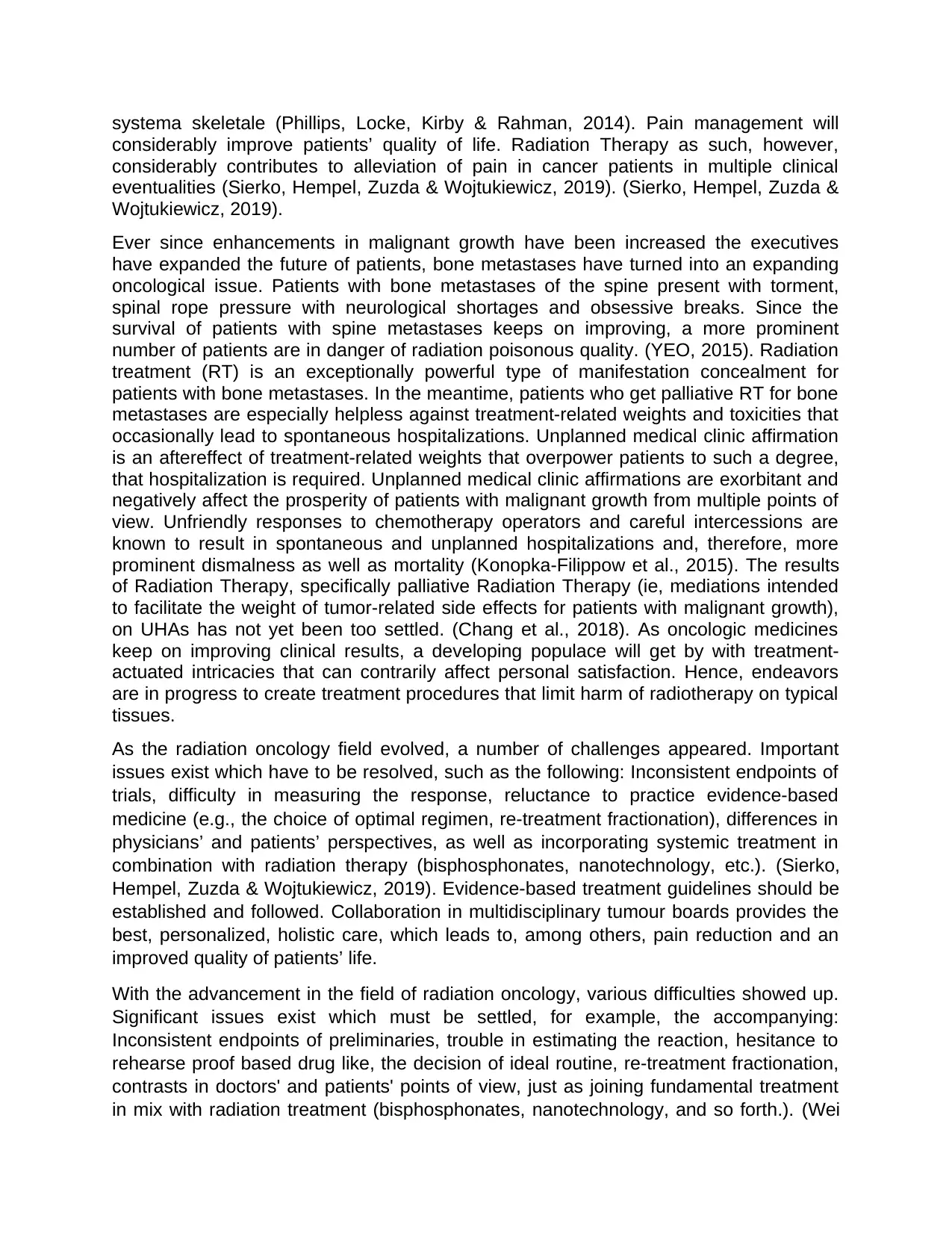Detailed Simulation Report: Radiation Therapy for Spine Cancer
VerifiedAdded on 2023/03/17
|9
|3691
|72
Report
AI Summary
This simulation report provides a comprehensive overview of the radiation therapy simulation process for a hypothetical 75-year-old patient diagnosed with lung cancer and experiencing spinal metastases. The report details the importance of patient data acquisition, the roles of the simulation team (physician, therapist, nurse, physicist, and dosimetrist), and the significance of comfortable patient positioning and immobilization. It also discusses the use of contrast, measurements, and marking techniques (including tattoos) for accurate treatment planning. The report highlights safety measures, potential side effects, and the importance of documentation, including photographs, for verification and future reference. The report emphasizes the recent advances in radiation oncology, such as CT-based 3D treatment planning and immobilization devices. Overall, the report showcases the detailed procedure required for a palliative radiation therapy simulation.

“Simulation Report”
Student Name:
Student Number:
Student Name:
Student Number:
Paraphrase This Document
Need a fresh take? Get an instant paraphrase of this document with our AI Paraphraser

Table of Contents
Introduction................................................................................................................................................3
Discussion.................................................................................................................................................4
Conclusion.................................................................................................................................................6
References................................................................................................................................................8
Introduction................................................................................................................................................3
Discussion.................................................................................................................................................4
Conclusion.................................................................................................................................................6
References................................................................................................................................................8

Introduction
A number cancer patients suffer from bone metastases every year, and one of the most
reported sites is the spine. This can cause the condition of the cancer patient even
worse due to constant unbearable pain thereby rendering the spine as mechanically
unstable (Husain et al., 2013). Patients opt for radiation therapy after the benign cancer
descends into the spine. Radiation oncology field in which ionizing radiations are
employed for the treatment of various malignancies, came into existence just after the
historical event of X Rays discovery and the effect they cause on the tissue during the
last decades of 19th century. Firstly the methods made use of the cathode ray tubes
having low energy for delivering single dosage, then after technological advancement
during mid-twentieth century the focus shifted on improving the energy and the beam
output. The discovery of Cobalt-60 units during 1950’s bought revolution in this field as
it was able to deliver the radiations having very high amount of voltage. These were
able to penetrate even more deeply into the tumors. Further advances in technology
lead towards achieving the goal of getting control over the cancerous growth by causing
minimal injury to the normal tissue (Liauw, Connell & Weichselbaum, 2013).
Radiation therapy is given in the form of external beam or in the form of brachytherapy
in which the source for radioactivity is kept inside the patient’s body where the site of
tumor is (Paravati et al., 2015). For a full-fledged and accurate radiation therapy to take
place the most important aspect is simulation. It is a process of defining the fields for
radiation treatment by filming and marking it on the patients skin. It is a huge scanning
machine which performs computed tomography in order to do contouring on the
patient’s body. After getting images, they are sent to the specialists who perform the
work of arranging the radiation beams and devise a customized plan for the any given
patient. Special attention is given to the point that the position should be made as
comfortable as possible and made sure that it could be used for providing the treatment
at any point of time. Measurements are very necessary to be made in a very accurate
manner since every individual is having a different physique. After taking all the
important parameters into consideration, it is then documented in a proper form in order
to proceed the treatment and to fill the records. This is the most important part of the
plan. After this process of contouring the body by CT scan, a plan is made by the doctor
on computer by arranging the beam accordingly.
The given report is about a hypothetical case of a patient who is an old man aged 75
years who was diagnosed with lung cancer three years ago. Now after three years he is
facing constant pain in his back. He has been advised for a CT Scan to check the
metastatic position of the tumor which is believed to be in the thoracic art of the spinal
cord. After getting the correct location he will be enrolled for palliative radiation therapy
of thoracic spine. The most important art of doing a simulation process is the acquisition
of patient’s data, as this data is very crucial for designing proper treatment plan for a
patient. This report will summarize the current landscape of recent biological and
A number cancer patients suffer from bone metastases every year, and one of the most
reported sites is the spine. This can cause the condition of the cancer patient even
worse due to constant unbearable pain thereby rendering the spine as mechanically
unstable (Husain et al., 2013). Patients opt for radiation therapy after the benign cancer
descends into the spine. Radiation oncology field in which ionizing radiations are
employed for the treatment of various malignancies, came into existence just after the
historical event of X Rays discovery and the effect they cause on the tissue during the
last decades of 19th century. Firstly the methods made use of the cathode ray tubes
having low energy for delivering single dosage, then after technological advancement
during mid-twentieth century the focus shifted on improving the energy and the beam
output. The discovery of Cobalt-60 units during 1950’s bought revolution in this field as
it was able to deliver the radiations having very high amount of voltage. These were
able to penetrate even more deeply into the tumors. Further advances in technology
lead towards achieving the goal of getting control over the cancerous growth by causing
minimal injury to the normal tissue (Liauw, Connell & Weichselbaum, 2013).
Radiation therapy is given in the form of external beam or in the form of brachytherapy
in which the source for radioactivity is kept inside the patient’s body where the site of
tumor is (Paravati et al., 2015). For a full-fledged and accurate radiation therapy to take
place the most important aspect is simulation. It is a process of defining the fields for
radiation treatment by filming and marking it on the patients skin. It is a huge scanning
machine which performs computed tomography in order to do contouring on the
patient’s body. After getting images, they are sent to the specialists who perform the
work of arranging the radiation beams and devise a customized plan for the any given
patient. Special attention is given to the point that the position should be made as
comfortable as possible and made sure that it could be used for providing the treatment
at any point of time. Measurements are very necessary to be made in a very accurate
manner since every individual is having a different physique. After taking all the
important parameters into consideration, it is then documented in a proper form in order
to proceed the treatment and to fill the records. This is the most important part of the
plan. After this process of contouring the body by CT scan, a plan is made by the doctor
on computer by arranging the beam accordingly.
The given report is about a hypothetical case of a patient who is an old man aged 75
years who was diagnosed with lung cancer three years ago. Now after three years he is
facing constant pain in his back. He has been advised for a CT Scan to check the
metastatic position of the tumor which is believed to be in the thoracic art of the spinal
cord. After getting the correct location he will be enrolled for palliative radiation therapy
of thoracic spine. The most important art of doing a simulation process is the acquisition
of patient’s data, as this data is very crucial for designing proper treatment plan for a
patient. This report will summarize the current landscape of recent biological and
⊘ This is a preview!⊘
Do you want full access?
Subscribe today to unlock all pages.

Trusted by 1+ million students worldwide

technological advances in radiation oncology and simulation by working on this virtual
case study of a patient.
Discussion
In order to make a simulation report it is very necessary to have all the data related to
the patient as it helps in making customized treatment plans. A particular set of
technicians and doctors is required for a proper simulation to take place. A team that
has a physician, a radiation therapist, an oncology nurse, medical physicist and a
medical dosimetrist fulfills the criteria of a good simulation team for a radiation therapy.
A physician who should be a radiation oncologist is the head of the simulation. The
therapist is directed by the physician only. A radiation therapist is a person who is
trained in the process of radio therapy. As he is certified so he takes part in the
simulation process and is there to administer treatments on a daily basis (Lutz et al.,
2017). The oncology nurse is a registered nurse who is a specialist of the concerns and
needs of the patient getting the therapy. Medical physicist is the person who is
responsible for the maintenance of all the equipment necessary for the process, he is
the specialist of the principles of radiation physics. Medical dosimetrist is the person
behind the calculation of dosage to be given in the therapy along with the physicist and
the radiation oncologist (Frankel, Wilén & Hansson Mild, 2018).
Because we need to mark the area of the skin before further proceedings so there
should be a gown which will be used every day with the same patient. This will nullify
the fear of not reproducing the same results every day. As the gown would be on the
same lace and of same fitting as it would be custom made for the patient. If the patient
wears any kind of jewelry then it should be taken off. Although this is a case of thoracic
spine there would not be any jewelry at that area but still it is always better not to have
any kind of metal during the session as they appear on the scan. Considering any kind
of precautions with the diet before the commencement of the procedure is not at all
necessary. The patient can have usual food or drink.
Getting a suitable and comfortable position for the patient is a very important step of the
simulation process. We should keep in mind that both the simulation as well the
treatment tables should be flat and hard in order to make sure that their position
remains relatively same during full course of treatment. The patient would be made to
lie on his stomach keeping his face turned to one side. This position can be altered by
the therapist if the patient would not be comfortable with it or he fails to maintain that
position. The patient should be made to feel very relax and easy at the time of
simulation as well as treatment. In the setting there is an intercom connected into the
system so that whenever the patient feels like speaking to the therapist about anything,
he can. As the procedure is quite lengthy, it may last for about half an hour to one hour
(Day, 2019).
After setting the proper position next step is to immobilize the patient, in this process the
position of the patient is fixed by some aids which are either ready to use or are
case study of a patient.
Discussion
In order to make a simulation report it is very necessary to have all the data related to
the patient as it helps in making customized treatment plans. A particular set of
technicians and doctors is required for a proper simulation to take place. A team that
has a physician, a radiation therapist, an oncology nurse, medical physicist and a
medical dosimetrist fulfills the criteria of a good simulation team for a radiation therapy.
A physician who should be a radiation oncologist is the head of the simulation. The
therapist is directed by the physician only. A radiation therapist is a person who is
trained in the process of radio therapy. As he is certified so he takes part in the
simulation process and is there to administer treatments on a daily basis (Lutz et al.,
2017). The oncology nurse is a registered nurse who is a specialist of the concerns and
needs of the patient getting the therapy. Medical physicist is the person who is
responsible for the maintenance of all the equipment necessary for the process, he is
the specialist of the principles of radiation physics. Medical dosimetrist is the person
behind the calculation of dosage to be given in the therapy along with the physicist and
the radiation oncologist (Frankel, Wilén & Hansson Mild, 2018).
Because we need to mark the area of the skin before further proceedings so there
should be a gown which will be used every day with the same patient. This will nullify
the fear of not reproducing the same results every day. As the gown would be on the
same lace and of same fitting as it would be custom made for the patient. If the patient
wears any kind of jewelry then it should be taken off. Although this is a case of thoracic
spine there would not be any jewelry at that area but still it is always better not to have
any kind of metal during the session as they appear on the scan. Considering any kind
of precautions with the diet before the commencement of the procedure is not at all
necessary. The patient can have usual food or drink.
Getting a suitable and comfortable position for the patient is a very important step of the
simulation process. We should keep in mind that both the simulation as well the
treatment tables should be flat and hard in order to make sure that their position
remains relatively same during full course of treatment. The patient would be made to
lie on his stomach keeping his face turned to one side. This position can be altered by
the therapist if the patient would not be comfortable with it or he fails to maintain that
position. The patient should be made to feel very relax and easy at the time of
simulation as well as treatment. In the setting there is an intercom connected into the
system so that whenever the patient feels like speaking to the therapist about anything,
he can. As the procedure is quite lengthy, it may last for about half an hour to one hour
(Day, 2019).
After setting the proper position next step is to immobilize the patient, in this process the
position of the patient is fixed by some aids which are either ready to use or are
Paraphrase This Document
Need a fresh take? Get an instant paraphrase of this document with our AI Paraphraser

constructed specially at the time of process. Some of the commonly used aids can be
tape, plaster casts, foam sponges, specially designed head rests or acrylic molds. In the
last decade the advancement in radiation oncology has brought about a revolution like
the development of various sophisticated immobilization devices, ultrafast flattening free
delivery treatment, CT based 3D treatment planning. (Husain et al., 2013).
Prior to the process of marking the field, a procedure of contrasting is also done. This
process is done in order to make better visualization of the area surrounding the
principle site. A dye is injected orally or intravenously, it makes the visualization of
certain organs much easier when they are circumference by a darker contrasting color.
However this process is employed only at the time of simulation, it is not at all required
at the time of treatment. Then further the process is proceeded by taking the
measurements, which are taken by the therapist. It would be marked by using some
wires or directly ink can be used on your skin. Since all the individuals are of different
shapes and sizes so various calculations are performed by the physicist. Further steps
are taken by combining the data of the physicist as well as the radiation oncologist in
order to decide the treatment plan. After the CT scan the physician will draw the action
plan for the treatment process by contouring the areas needed.
The most important step of the whole procedure is the reparation of site for the delivery
of radiation. It is necessary because of the accuracy and the reproducibility of the set u.
There are two methods available, invasive as well as noninvasive. Henna or marker en
are the noninvasive ones where as tattoo comes under the invasive one. Tattoo is made
by ricking the needle at an angle of 30° with a death of 1 to 2 mm to create a kind of dot
having 2 to 3 mm diameter. Tattoos have been found to be very useful as they look like
tiny freckle and unlike normal ink they don’t fade away which makes the physician
easier to aim the beam at the same target accurately every day. Its visibility, and being
permanent in nature are some of the social beliefs that are negatively associated with
its usage. Otherwise it still remains the first choice for the process of marking during
simulation for palliative treatment through radiation therapy. (Agarwal, Munshi &
Rathod, 2012)
For proper documentation a photograph of the marked area is taken. Patient is also
required to get his photograph clicked which could be used further in the process of
verification. A photograph of the whole simulation set is also clicked so that it may be
helpful in documentation if any item of the items is added or removed it can be cross
checked from the picture. It is also helpful when the radiation oncologist is absent from
the treatment lace for some reason, then the photograph can be referred and make the
setup easier. Dosimetrist also draw benefit from the photograph as sometimes viewing
the radiation on the patient through photograph can answer several calculation queries
that arise during the process of simulation.
While performing the simulation process one aspect is also there which should not be
neglected that is looking for the organs at risk. The organ which cannot tolerate the
dose received and may require a change in the dose or the arrangement of beam are
said to be the organs at risk. Those organs which are not immediately adjacent to the
tape, plaster casts, foam sponges, specially designed head rests or acrylic molds. In the
last decade the advancement in radiation oncology has brought about a revolution like
the development of various sophisticated immobilization devices, ultrafast flattening free
delivery treatment, CT based 3D treatment planning. (Husain et al., 2013).
Prior to the process of marking the field, a procedure of contrasting is also done. This
process is done in order to make better visualization of the area surrounding the
principle site. A dye is injected orally or intravenously, it makes the visualization of
certain organs much easier when they are circumference by a darker contrasting color.
However this process is employed only at the time of simulation, it is not at all required
at the time of treatment. Then further the process is proceeded by taking the
measurements, which are taken by the therapist. It would be marked by using some
wires or directly ink can be used on your skin. Since all the individuals are of different
shapes and sizes so various calculations are performed by the physicist. Further steps
are taken by combining the data of the physicist as well as the radiation oncologist in
order to decide the treatment plan. After the CT scan the physician will draw the action
plan for the treatment process by contouring the areas needed.
The most important step of the whole procedure is the reparation of site for the delivery
of radiation. It is necessary because of the accuracy and the reproducibility of the set u.
There are two methods available, invasive as well as noninvasive. Henna or marker en
are the noninvasive ones where as tattoo comes under the invasive one. Tattoo is made
by ricking the needle at an angle of 30° with a death of 1 to 2 mm to create a kind of dot
having 2 to 3 mm diameter. Tattoos have been found to be very useful as they look like
tiny freckle and unlike normal ink they don’t fade away which makes the physician
easier to aim the beam at the same target accurately every day. Its visibility, and being
permanent in nature are some of the social beliefs that are negatively associated with
its usage. Otherwise it still remains the first choice for the process of marking during
simulation for palliative treatment through radiation therapy. (Agarwal, Munshi &
Rathod, 2012)
For proper documentation a photograph of the marked area is taken. Patient is also
required to get his photograph clicked which could be used further in the process of
verification. A photograph of the whole simulation set is also clicked so that it may be
helpful in documentation if any item of the items is added or removed it can be cross
checked from the picture. It is also helpful when the radiation oncologist is absent from
the treatment lace for some reason, then the photograph can be referred and make the
setup easier. Dosimetrist also draw benefit from the photograph as sometimes viewing
the radiation on the patient through photograph can answer several calculation queries
that arise during the process of simulation.
While performing the simulation process one aspect is also there which should not be
neglected that is looking for the organs at risk. The organ which cannot tolerate the
dose received and may require a change in the dose or the arrangement of beam are
said to be the organs at risk. Those organs which are not immediately adjacent to the

targeted site but have very low tolerance for the dose should also be taken care of
(Schreiber, Safdieh, Becker & Schwartz, 2017).
There are certain safety measures that should be taken in the course of whole
procedure, during simulation as well as during the treatment process also. Also the
patient has to take a very good care of themselves after the process so as to cope up
with the radiation treatment. The following measures should be taken into consideration.
The patients should make sure that they should take plenty of rest, have a sound
sleep.
They should follow a balanced diet and always try to eat healthy.
The patients should provide a full list of the medicines and supplements that they
are taking.
They should take good care of their skin where the treatment has been
performed.
They should not use any kind of deodorant, or soaps etc., over the treated area
before consulting to their doctor ("Coping With Radiation Treatment", 2019).
The side effects from the radiation therapy could be divided into two broader categories,
Early side effects
These side effects happen immediately after the treatment, they are short term and
treatable. They generally go with in a few weeks after the end of the treatment.
Some of the common early side effects are skin problems, fatigue etc.
Late side effects
These type of side effects can take longer time to vanish, they make take some
months or over a year to get away. Their intensity depends upon the dosage used,
and the area of treatment. They can occur at any of the normal tissue of the body
where radiation is received.
Conclusion
Palliative radiation therapy for spine metastases has been performed since long
employing a 2 dimensional technique with associate X-ray machine and portal films; this
straightforward technique has blessings in terms of the fast initiation of treatment for
symptom management. However, this method is suboptimal for reducing superfluous
radiation exposure to neighboring healthy tissues (YEO, 2015). The bulk of cancer
patients suffer from pain throughout course of their sickness. Pain is also a results of a
growing primary tumor, metastases in liquid body substance nodes, however
predominately it happens in patients experiencing distant metastases, notably to the
(Schreiber, Safdieh, Becker & Schwartz, 2017).
There are certain safety measures that should be taken in the course of whole
procedure, during simulation as well as during the treatment process also. Also the
patient has to take a very good care of themselves after the process so as to cope up
with the radiation treatment. The following measures should be taken into consideration.
The patients should make sure that they should take plenty of rest, have a sound
sleep.
They should follow a balanced diet and always try to eat healthy.
The patients should provide a full list of the medicines and supplements that they
are taking.
They should take good care of their skin where the treatment has been
performed.
They should not use any kind of deodorant, or soaps etc., over the treated area
before consulting to their doctor ("Coping With Radiation Treatment", 2019).
The side effects from the radiation therapy could be divided into two broader categories,
Early side effects
These side effects happen immediately after the treatment, they are short term and
treatable. They generally go with in a few weeks after the end of the treatment.
Some of the common early side effects are skin problems, fatigue etc.
Late side effects
These type of side effects can take longer time to vanish, they make take some
months or over a year to get away. Their intensity depends upon the dosage used,
and the area of treatment. They can occur at any of the normal tissue of the body
where radiation is received.
Conclusion
Palliative radiation therapy for spine metastases has been performed since long
employing a 2 dimensional technique with associate X-ray machine and portal films; this
straightforward technique has blessings in terms of the fast initiation of treatment for
symptom management. However, this method is suboptimal for reducing superfluous
radiation exposure to neighboring healthy tissues (YEO, 2015). The bulk of cancer
patients suffer from pain throughout course of their sickness. Pain is also a results of a
growing primary tumor, metastases in liquid body substance nodes, however
predominately it happens in patients experiencing distant metastases, notably to the
⊘ This is a preview!⊘
Do you want full access?
Subscribe today to unlock all pages.

Trusted by 1+ million students worldwide

systema skeletale (Phillips, Locke, Kirby & Rahman, 2014). Pain management will
considerably improve patients’ quality of life. Radiation Therapy as such, however,
considerably contributes to alleviation of pain in cancer patients in multiple clinical
eventualities (Sierko, Hempel, Zuzda & Wojtukiewicz, 2019). (Sierko, Hempel, Zuzda &
Wojtukiewicz, 2019).
Ever since enhancements in malignant growth have been increased the executives
have expanded the future of patients, bone metastases have turned into an expanding
oncological issue. Patients with bone metastases of the spine present with torment,
spinal rope pressure with neurological shortages and obsessive breaks. Since the
survival of patients with spine metastases keeps on improving, a more prominent
number of patients are in danger of radiation poisonous quality. (YEO, 2015). Radiation
treatment (RT) is an exceptionally powerful type of manifestation concealment for
patients with bone metastases. In the meantime, patients who get palliative RT for bone
metastases are especially helpless against treatment-related weights and toxicities that
occasionally lead to spontaneous hospitalizations. Unplanned medical clinic affirmation
is an aftereffect of treatment-related weights that overpower patients to such a degree,
that hospitalization is required. Unplanned medical clinic affirmations are exorbitant and
negatively affect the prosperity of patients with malignant growth from multiple points of
view. Unfriendly responses to chemotherapy operators and careful intercessions are
known to result in spontaneous and unplanned hospitalizations and, therefore, more
prominent dismalness as well as mortality (Konopka-Filippow et al., 2015). The results
of Radiation Therapy, specifically palliative Radiation Therapy (ie, mediations intended
to facilitate the weight of tumor-related side effects for patients with malignant growth),
on UHAs has not yet been too settled. (Chang et al., 2018). As oncologic medicines
keep on improving clinical results, a developing populace will get by with treatment-
actuated intricacies that can contrarily affect personal satisfaction. Hence, endeavors
are in progress to create treatment procedures that limit harm of radiotherapy on typical
tissues.
As the radiation oncology field evolved, a number of challenges appeared. Important
issues exist which have to be resolved, such as the following: Inconsistent endpoints of
trials, difficulty in measuring the response, reluctance to practice evidence-based
medicine (e.g., the choice of optimal regimen, re-treatment fractionation), differences in
physicians’ and patients’ perspectives, as well as incorporating systemic treatment in
combination with radiation therapy (bisphosphonates, nanotechnology, etc.). (Sierko,
Hempel, Zuzda & Wojtukiewicz, 2019). Evidence-based treatment guidelines should be
established and followed. Collaboration in multidisciplinary tumour boards provides the
best, personalized, holistic care, which leads to, among others, pain reduction and an
improved quality of patients’ life.
With the advancement in the field of radiation oncology, various difficulties showed up.
Significant issues exist which must be settled, for example, the accompanying:
Inconsistent endpoints of preliminaries, trouble in estimating the reaction, hesitance to
rehearse proof based drug like, the decision of ideal routine, re-treatment fractionation,
contrasts in doctors' and patients' points of view, just as joining fundamental treatment
in mix with radiation treatment (bisphosphonates, nanotechnology, and so forth.). (Wei
considerably improve patients’ quality of life. Radiation Therapy as such, however,
considerably contributes to alleviation of pain in cancer patients in multiple clinical
eventualities (Sierko, Hempel, Zuzda & Wojtukiewicz, 2019). (Sierko, Hempel, Zuzda &
Wojtukiewicz, 2019).
Ever since enhancements in malignant growth have been increased the executives
have expanded the future of patients, bone metastases have turned into an expanding
oncological issue. Patients with bone metastases of the spine present with torment,
spinal rope pressure with neurological shortages and obsessive breaks. Since the
survival of patients with spine metastases keeps on improving, a more prominent
number of patients are in danger of radiation poisonous quality. (YEO, 2015). Radiation
treatment (RT) is an exceptionally powerful type of manifestation concealment for
patients with bone metastases. In the meantime, patients who get palliative RT for bone
metastases are especially helpless against treatment-related weights and toxicities that
occasionally lead to spontaneous hospitalizations. Unplanned medical clinic affirmation
is an aftereffect of treatment-related weights that overpower patients to such a degree,
that hospitalization is required. Unplanned medical clinic affirmations are exorbitant and
negatively affect the prosperity of patients with malignant growth from multiple points of
view. Unfriendly responses to chemotherapy operators and careful intercessions are
known to result in spontaneous and unplanned hospitalizations and, therefore, more
prominent dismalness as well as mortality (Konopka-Filippow et al., 2015). The results
of Radiation Therapy, specifically palliative Radiation Therapy (ie, mediations intended
to facilitate the weight of tumor-related side effects for patients with malignant growth),
on UHAs has not yet been too settled. (Chang et al., 2018). As oncologic medicines
keep on improving clinical results, a developing populace will get by with treatment-
actuated intricacies that can contrarily affect personal satisfaction. Hence, endeavors
are in progress to create treatment procedures that limit harm of radiotherapy on typical
tissues.
As the radiation oncology field evolved, a number of challenges appeared. Important
issues exist which have to be resolved, such as the following: Inconsistent endpoints of
trials, difficulty in measuring the response, reluctance to practice evidence-based
medicine (e.g., the choice of optimal regimen, re-treatment fractionation), differences in
physicians’ and patients’ perspectives, as well as incorporating systemic treatment in
combination with radiation therapy (bisphosphonates, nanotechnology, etc.). (Sierko,
Hempel, Zuzda & Wojtukiewicz, 2019). Evidence-based treatment guidelines should be
established and followed. Collaboration in multidisciplinary tumour boards provides the
best, personalized, holistic care, which leads to, among others, pain reduction and an
improved quality of patients’ life.
With the advancement in the field of radiation oncology, various difficulties showed up.
Significant issues exist which must be settled, for example, the accompanying:
Inconsistent endpoints of preliminaries, trouble in estimating the reaction, hesitance to
rehearse proof based drug like, the decision of ideal routine, re-treatment fractionation,
contrasts in doctors' and patients' points of view, just as joining fundamental treatment
in mix with radiation treatment (bisphosphonates, nanotechnology, and so forth.). (Wei
Paraphrase This Document
Need a fresh take? Get an instant paraphrase of this document with our AI Paraphraser

et al., 2017, Sierko, Hempel, Zuzda and Wojtukiewicz, 2019). Proof based treatment
rules ought to be built up and pursued. Coordinated effort in multidisciplinary tumor
sheets gives the best, customized, all-encompassing consideration, which prompts,
among others, torment decrease and an improved nature of the life of a patient.
References
Agarwal, J., Munshi, A., & Rathod, S. (2012). Skin markings methods and guidelines: A
reality in image guidance radiotherapy era. South Asian Journal Of Cancer, 1(1),
27. doi: 10.4103/2278-330x.96502
Chang, S., Ru, M., Moshier, E., Mazumdar, M., Ricks, D., & Goldstein, N. et al. (2018).
The impact of radiation treatment planning technique on unplanned hospital
admissions. Advances In Radiation Oncology, 3(4), 647-654. doi:
10.1016/j.adro.2018.06.006
Coping With Radiation Treatment. (2019). Retrieved from
https://www.cancer.org/treatment/treatments-and-side-effects/treatment-types/
radiation/coping.html
Day, J. (2019). Radiation Therapy Simulation: What to Expect | Sibley Memorial in
Washington D.C. Retrieved from https://www.hopkinsmedicine.org/sibley-memorial-
hospital/patient-care/specialty/cancer/treatment/radiation-oncology/radiation-
therapy-simulation.html
Frankel, J., Wilén, J., & Hansson Mild, K. (2018). Assessing Exposures to Magnetic
Resonance Imaging’s Complex Mixture of Magnetic Fields for In Vivo, In Vitro, and
Epidemiologic Studies of Health Effects for Staff and Patients. Frontiers In Public
Health, 6. doi: 10.3389/fpubh.2018.00066
Husain, Z., Thibault, I., Letourneau, D., Ma, L., Keller, H., & Suh, J. et al. (2013).
Stereotactic body radiotherapy: a new paradigm in the management of spinal
metastases. CNS Oncology, 2(3), 259-270. doi: 10.2217/cns.13.11
Konopka-Filippow, M., Zabrocka, E., Wójtowicz, A., Skalij, P., Wojtukiewicz, M., &
Sierko, E. (2015). Pain management during radiotherapy and radiochemotherapy in
oropharyngeal cancer patients: single-institution experience. International Dental
Journal, 65(5), 242-248. doi: 10.1111/idj.12181
Liauw, S., Connell, P., & Weichselbaum, R. (2013). New Paradigms and Future
Challenges in Radiation Oncology: An Update of Biological Targets and
Technology. Science Translational Medicine, 5(173), 173sr2-173sr2. doi:
10.1126/scitranslmed.3005148
rules ought to be built up and pursued. Coordinated effort in multidisciplinary tumor
sheets gives the best, customized, all-encompassing consideration, which prompts,
among others, torment decrease and an improved nature of the life of a patient.
References
Agarwal, J., Munshi, A., & Rathod, S. (2012). Skin markings methods and guidelines: A
reality in image guidance radiotherapy era. South Asian Journal Of Cancer, 1(1),
27. doi: 10.4103/2278-330x.96502
Chang, S., Ru, M., Moshier, E., Mazumdar, M., Ricks, D., & Goldstein, N. et al. (2018).
The impact of radiation treatment planning technique on unplanned hospital
admissions. Advances In Radiation Oncology, 3(4), 647-654. doi:
10.1016/j.adro.2018.06.006
Coping With Radiation Treatment. (2019). Retrieved from
https://www.cancer.org/treatment/treatments-and-side-effects/treatment-types/
radiation/coping.html
Day, J. (2019). Radiation Therapy Simulation: What to Expect | Sibley Memorial in
Washington D.C. Retrieved from https://www.hopkinsmedicine.org/sibley-memorial-
hospital/patient-care/specialty/cancer/treatment/radiation-oncology/radiation-
therapy-simulation.html
Frankel, J., Wilén, J., & Hansson Mild, K. (2018). Assessing Exposures to Magnetic
Resonance Imaging’s Complex Mixture of Magnetic Fields for In Vivo, In Vitro, and
Epidemiologic Studies of Health Effects for Staff and Patients. Frontiers In Public
Health, 6. doi: 10.3389/fpubh.2018.00066
Husain, Z., Thibault, I., Letourneau, D., Ma, L., Keller, H., & Suh, J. et al. (2013).
Stereotactic body radiotherapy: a new paradigm in the management of spinal
metastases. CNS Oncology, 2(3), 259-270. doi: 10.2217/cns.13.11
Konopka-Filippow, M., Zabrocka, E., Wójtowicz, A., Skalij, P., Wojtukiewicz, M., &
Sierko, E. (2015). Pain management during radiotherapy and radiochemotherapy in
oropharyngeal cancer patients: single-institution experience. International Dental
Journal, 65(5), 242-248. doi: 10.1111/idj.12181
Liauw, S., Connell, P., & Weichselbaum, R. (2013). New Paradigms and Future
Challenges in Radiation Oncology: An Update of Biological Targets and
Technology. Science Translational Medicine, 5(173), 173sr2-173sr2. doi:
10.1126/scitranslmed.3005148

Lutz, S., Balboni, T., Jones, J., Lo, S., Petit, J., & Rich, S. et al. (2017). Palliative
radiation therapy for bone metastases: Update of an ASTRO Evidence-Based
Guideline. Practical Radiation Oncology, 7(1), 4-12. doi: 10.1016/j.prro.2016.08.001
Paravati, A., Boero, I., Triplett, D., Hwang, L., Matsuno, R., & Xu, B. et al. (2015).
Variation in the Cost of Radiation Therapy Among Medicare Patients With
Cancer. Journal Of Oncology Practice, 11(5), 403-409. doi:
10.1200/jop.2015.005694
Phillips, I., Locke, I., Kirby, A., & Rahman, F. (2014). Palliative External Beam
Radiotherapy for Painful Bone Metastases. Clinical Oncology, 26, S2-S3. doi:
10.1016/j.clon.2014.04.005
Schreiber, D., Safdieh, J., Becker, D., & Schwartz, D. (2017). Patterns of care and
survival outcomes of palliative radiation for prostate cancer with bone metastases:
comparison of ≤5 fractions to ≥10 fractions. Annals Of Palliative Medicine, 6(1), 55-
65. doi: 10.21037/apm.2016.12.07
Sierko, E., Hempel, D., Zuzda, K., & Wojtukiewicz, M. (2019). Personalized Radiation
Therapy in Cancer Pain Management. Cancers, 11(3), 390. doi:
10.3390/cancers11030390
Wei, R., Mattes, M., Yu, J., Thrasher, A., Shu, H., & Paganetti, H. et al. (2017). Attitudes
of radiation oncologists toward palliative and supportive care in the United States:
Report on national membership survey by the American Society for Radiation
Oncology (ASTRO). Practical Radiation Oncology, 7(2), 113-119. doi:
10.1016/j.prro.2016.08.017
YEO, S. (2015). Palliative radiotherapy for thoracic spine metastases: Dosimetric
advantage of three-dimensional conformal plans. Oncology Letters, 10(1), 497-501.
doi: 10.3892/ol.2015.3205
radiation therapy for bone metastases: Update of an ASTRO Evidence-Based
Guideline. Practical Radiation Oncology, 7(1), 4-12. doi: 10.1016/j.prro.2016.08.001
Paravati, A., Boero, I., Triplett, D., Hwang, L., Matsuno, R., & Xu, B. et al. (2015).
Variation in the Cost of Radiation Therapy Among Medicare Patients With
Cancer. Journal Of Oncology Practice, 11(5), 403-409. doi:
10.1200/jop.2015.005694
Phillips, I., Locke, I., Kirby, A., & Rahman, F. (2014). Palliative External Beam
Radiotherapy for Painful Bone Metastases. Clinical Oncology, 26, S2-S3. doi:
10.1016/j.clon.2014.04.005
Schreiber, D., Safdieh, J., Becker, D., & Schwartz, D. (2017). Patterns of care and
survival outcomes of palliative radiation for prostate cancer with bone metastases:
comparison of ≤5 fractions to ≥10 fractions. Annals Of Palliative Medicine, 6(1), 55-
65. doi: 10.21037/apm.2016.12.07
Sierko, E., Hempel, D., Zuzda, K., & Wojtukiewicz, M. (2019). Personalized Radiation
Therapy in Cancer Pain Management. Cancers, 11(3), 390. doi:
10.3390/cancers11030390
Wei, R., Mattes, M., Yu, J., Thrasher, A., Shu, H., & Paganetti, H. et al. (2017). Attitudes
of radiation oncologists toward palliative and supportive care in the United States:
Report on national membership survey by the American Society for Radiation
Oncology (ASTRO). Practical Radiation Oncology, 7(2), 113-119. doi:
10.1016/j.prro.2016.08.017
YEO, S. (2015). Palliative radiotherapy for thoracic spine metastases: Dosimetric
advantage of three-dimensional conformal plans. Oncology Letters, 10(1), 497-501.
doi: 10.3892/ol.2015.3205
⊘ This is a preview!⊘
Do you want full access?
Subscribe today to unlock all pages.

Trusted by 1+ million students worldwide
1 out of 9
Related Documents
Your All-in-One AI-Powered Toolkit for Academic Success.
+13062052269
info@desklib.com
Available 24*7 on WhatsApp / Email
![[object Object]](/_next/static/media/star-bottom.7253800d.svg)
Unlock your academic potential
Copyright © 2020–2025 A2Z Services. All Rights Reserved. Developed and managed by ZUCOL.



